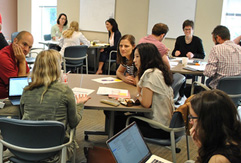Evaluation Observation Instructions
The ECO-STEM Peer Observation Tool can be used in a variety of ways for the Retention, Tenure, and Promotion process.
1. As part of a self-reflection. In this case, see instructions for Peer-Observation.
2. As part of an official observation. With the observer, follow Steps 1 – 6 below. The notes and class observation will form the basis of an observation report.

|
Step 1: (Each instructor individually)
Familiarize yourself with the tool by using the summary version of the observation tool. It is broken into the three areas of climate, structure, and vibrancy. You may have identified an aspect of your class that you want to change – think about |

|
Step 2: Meet with your peer observer (whom you will observe in turn). Discuss your overarching goals for the observation and the list of observable behaviors you want to focus on. Together with the observer, narrow down the list to around 10 observable behaviors, using the feedback from the discussion with the peer observer who may have given feedback on additional/alternative ways you could get at your goal.
Step 3: Now work through the observer’s list of observable behaviors and be a sounding board for your partner. Assist your partner in narrowing down his/her list to 10 observable items. If the class to be observed is taught online, then make sure to select behaviors that can be observed in that environment and arrange for the observer to be able to access your class. Create a tailored observation form https://ecostem.calstatela.edu/pot with only your selected behaviors that your peer can use in the observation. |

|
Step 4: Identify dates for classes in which you will observe each other. If one or both of you teach online, then you should look at which of the items you have identified are applicable. Adjust as you need to. Also select a date for debrief. If a class takes place online, the observer should get information on how to access the class – maybe be temporarily enrolled in the course as an observer. |

|
Step 5: Visit and observe each other’s classes using tailored observation form. |

|
Step 6: Meet to debrief. Exchange your completed observation tools with your respective assessments on how prevalent the selected behaviors were during the observations, and any additional notes the observer made. |